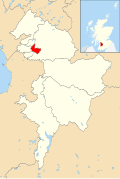| Kilmarnock East and Hurlford | |
|---|---|
| East Ayrshire | |
 Boundary of Kilmarnock East and Hurlford in East Ayrshire from 2007–2017. | |
| Population | 15,570 (2021) [1] |
| Electorate | 12,370 (2022) |
| Major settlements | Hurlford Kilmarnock (part of) |
| Scottish Parliament constituency | Kilmarnock and Irvine Valley |
| Scottish Parliament region | South Scotland |
| UK Parliament constituency | Kilmarnock and Loudon |
| Current ward | |
| Created | 2007 |
| Number of councillors | 4 |
| Councillor | Barry Douglas (Labour) |
| Councillor | Graham Barton (SNP) |
| Councillor | Graham Boyd (Independent) |
| Councillor | Neal Ingram (SNP) |
| Created from | Crookedholm, Moscow, Galston West and Hurlford North Hurlford Kilmarnock Central East Kilmarnock Central South North New Farm Loch and Dean South New Farm Loch |
Kilmarnock East and Hurlford is one of the nine wards used to elect members of the East Ayrshire Council. It elects four councillors using the single transferable vote electoral system and covers an area with a population of 15,570 people.
Contents
- Boundaries
- Councillors
- Election results
- 2022 election
- 2017 election
- 2017 by-election
- 2012 election
- 2007 election
- Notes
- References
The area has produced strong results for both Labour and the Scottish National Party (SNP) with the former holding two seats between 2007 and 2017 and the latter taking half the seats at every election.